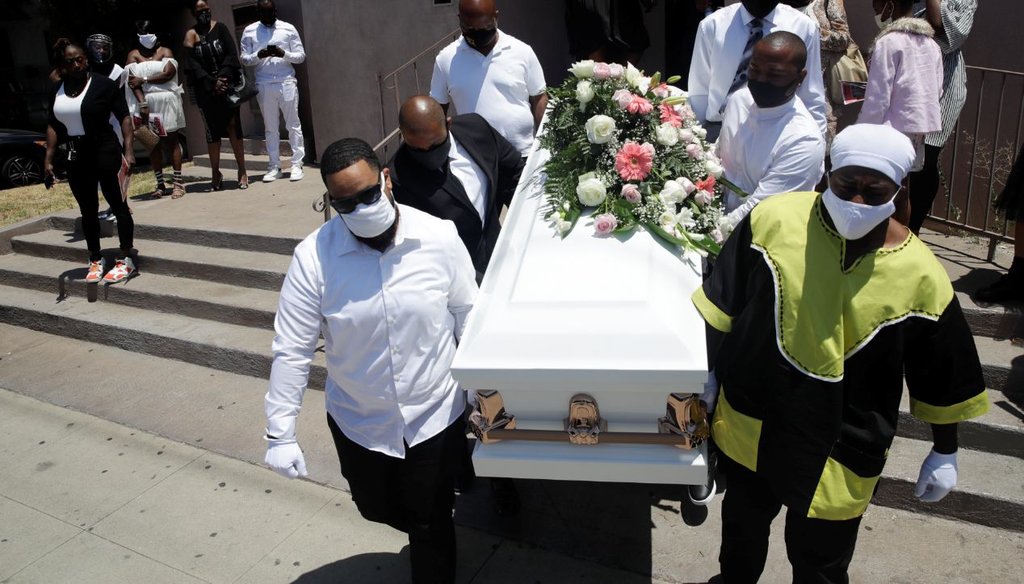Get PolitiFact in your inbox.

Pallbearers carry a casket with the body of Lydia Nunez, who died from COVID-19, after a funeral service in Los Angeles on July 21, 2020. (AP)
If Your Time is short
• Through Feb. 23, 2021, a total of 502,005 Americans died of COVID-19. That’s more than any single annual cause of death in the U.S. in 2019, other than heart disease and cancer.
• Looked at another way, the Centers for Disease Control currently counts 559,887 deaths beyond typical levels before the pandemic began.
Now that the coronavirus has been in the United States for roughly a year, new numbers are revealing the scale of COVID-19’s impact on American health: COVID-19 has become the country’s third leading cause of death, and could be on its way to outpacing cancer.
Through Feb. 23, 2021, a total of 502,005 Americans died of the coronavirus, according to Johns Hopkins University data. And a closely watched model from researchers at the University of Washington projects that this number will rise past 589,000 by June 1.
"The toll of death is simply staggering — worse than I would have predicted," said Arthur L. Caplan, founding head of the division of medical ethics at the New York University School of Medicine. "COVID has been nothing short of the worst failure of public policy in modern memory."
With a year’s worth of data, it’s possible to look more precisely at how the coronavirus compares with the more routine causes of death in the U.S.
In the chart below, we compare the coronavirus death figure (in red) over the past year or so, with the 10 leading causes of death in 2019, the last year for which full data is available from the Centers for Disease Control and Prevention.
The takeaway is that the coronavirus killed more Americans in the past year than any cause of death in 2019, other than heart disease and cancer. And if the University of Washington model proves accurate, then by June, the 15-month toll from the coronavirus will be close to matching the annual number of deaths from cancer.
All other causes of death pale in comparison to the coronavirus death toll so far. So far, the coronavirus has killed roughly three times as many people as accidents, or lung ailments, or stroke or Alzheimer’s disease did in 2019. And the coronavirus has outpaced the number of deaths from diabetes, kidney disease, pneumonia and suicide by even larger multiples.
Caution is warranted when comparing these causes of death. Most of the 10 leading causes of death are not primarily driven by infections, whereas the coronavirus is. So it’s hard to imagine a scenario in which any of the other causes could spike the way coronavirus did.
Another way to look at the toll of the coronavirus pandemic is by considering "excess deaths," a statistic tracked by the CDC. This data takes the number of actual deaths in a given period and subtracts the average number of deaths from all causes during the comparable period in recent years.
The CDC data shows how excess deaths have risen with spikes in COVID-19 infections. In some weeks over the past year, there were as many as 22,000 excess deaths.
The weekly excess deaths add up to 559,887 additional deaths since the pandemic began.
That’s a bit higher than the 502,005 coronavirus deaths officially recorded. However, the additional 58,000 deaths could reflect a combination of coronavirus deaths that didn’t get recorded as such; deaths caused by people unwilling or unable to go to the hospital for other serious illnesses during the pandemic; or from overdoses or suicides stemming from increased social isolation during the pandemic. (Because of reporting lags, the death certificates used to determine excess deaths tend to understate recent weeks’ totals and are expected to increase in future weeks as more data rolls in.)
"There is nothing like these abstract statistics to illustrate the ‘psychic numbing’ we experience when dealing with large-scale loss of life," said David Ropeik, author of the book "How Risky Is it, Really? Why Our Fears Don’t Always Match the Facts."
"It’s unlikely that, as stark as these figures are, that they will evoke nearly as much emotion as the personal story of any one of these victims," Ropeik said. "A risk depicted as a face, or a name, that is ‘personified,’ is one we can imagine happening to ourselves. Statistics are inhuman and far less moving."
Our Sources
Johns Hopkins University Coronavirus Resource Center, live data feed, accessed Feb. 23, 2021
University of Washington Institute for Health Metrics and Evaluation, COVID-19 projections, accessed Feb. 23, 2021
Centers for Disease Control and Prevention, "Number of deaths, percentage of total deaths, and age-adjusted death rates for the 10 leading causes of death in 2019: United States, 2018 and 2019," accessed Feb. 23, 2021
Centers for Disease Control and Prevention, "Excess Deaths Associated with COVID-19," accessed Feb. 23, 2021
PolitiFact, "Understanding the scale of potential coronavirus deaths," April 3, 2021
Email interview with David Ropeik, author of the book "How Risky Is it, Really? Why Our Fears Don’t Always Match the Facts," Feb. 23, 2021
Email interview with Arthur L. Caplan, founding head of the division of medical ethics at the New York University School of Medicine, Feb. 23, 2021






































